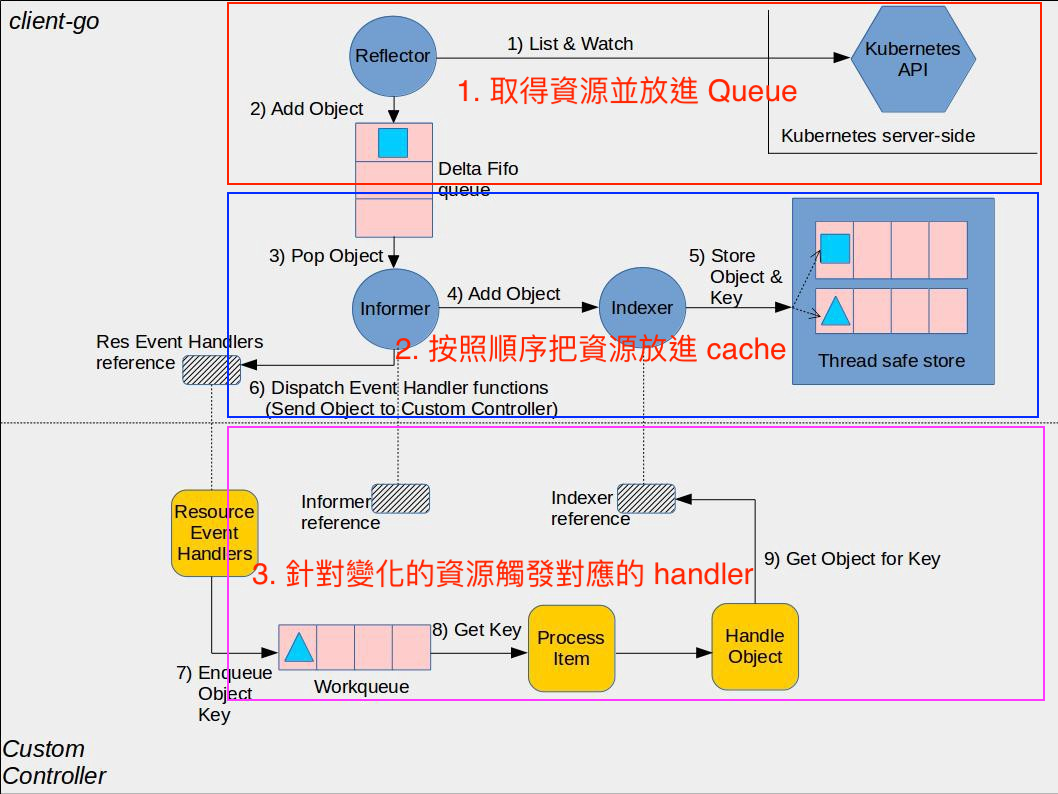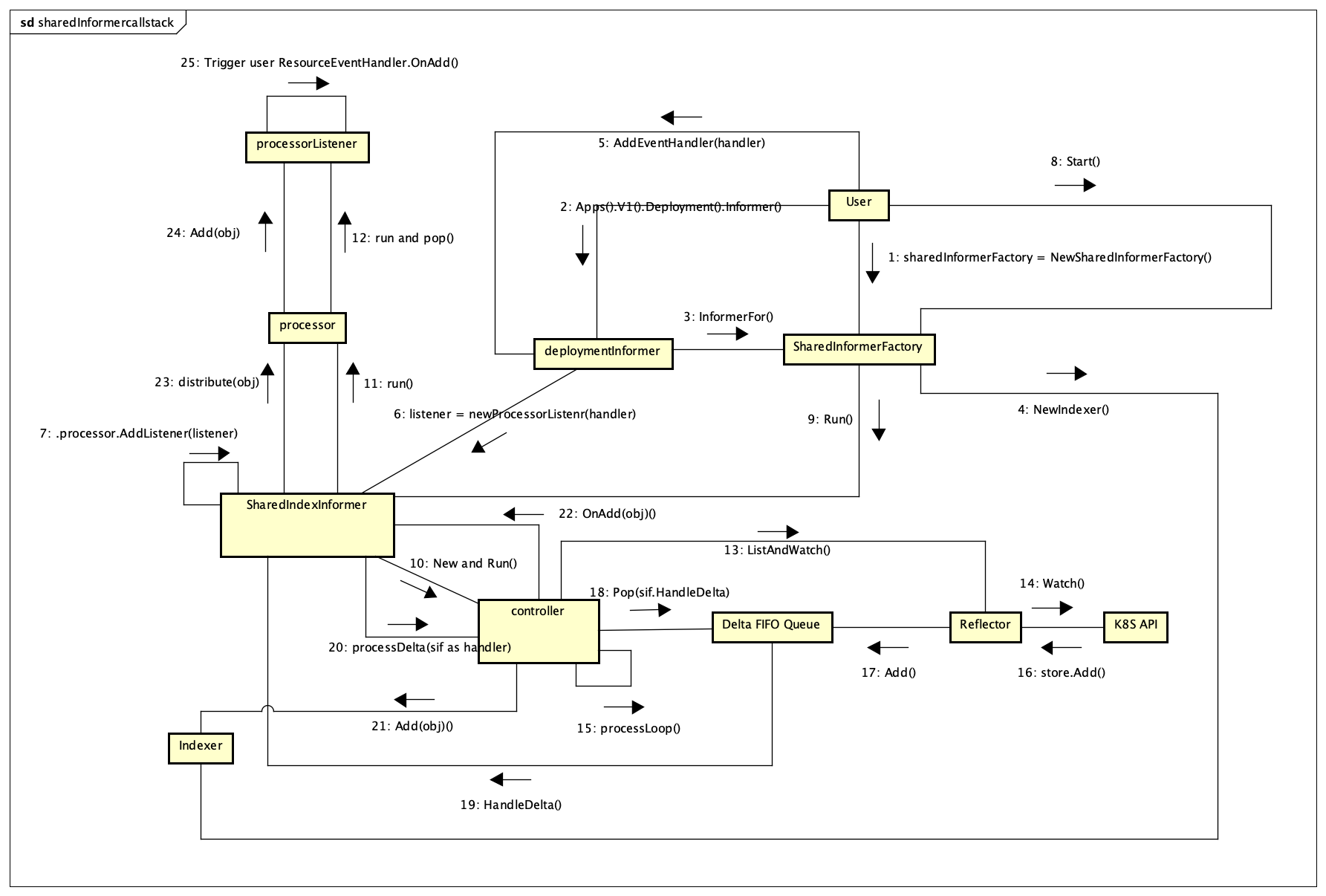前言
client-go 是由 kubernetes 提供的套件,包含很多 kubernetes 互動的功能,最常見的就是可以透過 client-go 去呼叫 kubernetes API 以及撰寫 Controller 等等功能,這篇文章會圍繞在撰寫 Controller 時需要的 Informer 的架構為主,但我會先從脫離 client-go 的概念上解釋 Informer 這個東西的存在,再來帶到 Informer 中各個元件做的事情。
概念
在進入到 Informer 之前,先想想呼叫 kubernetes API 取得資源這件事,如果我們想對資源變化前後去做對應的行為,很直覺的做法就是不斷 pulling,然後偵測到前後差異,等到有變化的時候,再把訊息往下傳,接著再做對應的處理。而 client-go 針對上述的流程進行優化以及解耦合,讓整體的概念上更清楚以及分工更細節,也就是說其實你可以不用透過 client-go 也能做到 client-go 本身要做的事情,當然就是得自己刻套件。
根據上述描述的流程可以拆成以下幾個部分:
- 取得 kubenetes resource
- 傳遞 resource
- 針對 resource 變化進行對應的處理
而 client-go 提供的 Informer 就是針對以上這三塊去進行優化,不過在個人了解完之後,我覺得 Informer 比較像是一個 template,透過提供正確的 input output 後,就會做到以上三件事情。
在提到 client-go 做什麼之前,我們先想一下平常我們是怎麼做 API 優化的。通常在取得 API resource 回來使用後,下次想要取得就會需要再 call API,但這帶來的問題就是成本過高。所以下一步通常會採用 cache 的方式,讓下次取得資源不用 call API 直接從 cache 裡面拿即可。
而通常當兩個 service 之間都是用 API 溝通的話,這會帶來一些潛在的問題,其中之一就是當其中一個 service 掛掉之後,整體 service 就會掛掉。舉例來說 A service 呼叫 B service 要去做信件寄送,如果此時 B service 壞掉的話,A service 可能會得到連線錯誤的資訊,原本定義好的流程就會卡在這。而要解決這個問題的其中一個方式就是要解耦和,可以利用 asynchronous 去處理,可能是建立一個 queue 並且雙邊都用這個 queue 去溝通。
會發現這樣的架構像是微服務中的一種溝通方式,然後按照上述基本的優化,可以把原本流程改成以下的部分:
- 取得 kubernetes resource 放進 queue
- 將從 queue 取得到的 resource 放進 cache
- 從 queue 取得變化的 resource 並進行對應處理
說穿了 Informer 就是去進行以上的優化,並提供 template 來使用,而常聽到的 Reflector, ListAndWatch, Indexers 等等,就是製作這個 template 的眾多必要元素。
Informer
Informer 需要以下三個東西才可以完成整個流程:
- 如何取得 resources 並放進 queue
- 如何處理得到的 resources 放進 cache
- 如何處理變化的 resource 事件
接著就可以把以上的概念對應到這個圖上 
以下 client-go 程式是基於 v0.28.3
如何取得 resources 並放進 queue
在 Informer 裡面是透過 Reflector 完成的,但其實還有一個更小的元素叫做 ListAndWatch,如同名字就是去 List 和 Watch resources。舉例來說可以透過 Watch 監測 Deployment 並且使用 ResultChan 可以拿到每一個變化的事件。1
2
3
4
5
6
7
8
9
10
11
12
13
14
15
16
17watcher, err := kubeClient.
AppsV1().
Deployments("").
Watch(context.Background(), metav1.ListOptions{})
if err != nil {
panic(err)
}
for event := range watcher.ResultChan() {
deployment := event.Object.(*appsv1.Deployment)
switch event.Type {
case watch.Added:
case watch.Modified:
case watch.Deleted:
}
}
而我們實際在 NewInformer 的時候,就會需要把這個傳進去讓 Reflector 去做使用。1
2
3lister := cache.NewListWatchFromClient(kubeClient.AppsV1().RESTClient(), "deployments", metav1.NamespaceAll, fields.Everything())
// 在 NewInformer 底下會去 NewReflector
cache.NewInformer(lister, &appsv1.Deployment{}, 0, cache.ResourceEventHandlerFuncs{ /* ...略 */ })
實際看一下 NewListWatchFromClient 會發現跟剛剛使用的 Watch 很相似。1
2
3
4
5
6
7
8
9
10
11
12
13
14
15
16
17
18
19
20
21
22// client-go/tools/cache/listwatch.go
func NewFilteredListWatchFromClient(c Getter, resource string, namespace string, optionsModifier func(options *metav1.ListOptions)) *ListWatch {
listFunc := func(options metav1.ListOptions) (runtime.Object, error) {
optionsModifier(&options)
return c.Get().
Namespace(namespace).
Resource(resource).
VersionedParams(&options, metav1.ParameterCodec).
Do(context.TODO()).
Get()
}
watchFunc := func(options metav1.ListOptions) (watch.Interface, error) {
options.Watch = true
optionsModifier(&options)
return c.Get().
Namespace(namespace).
Resource(resource).
VersionedParams(&options, metav1.ParameterCodec).
Watch(context.TODO())
}
return &ListWatch{ListFunc: listFunc, WatchFunc: watchFunc}
}
接著就是要把得到的結果放進到 queue 裡面,讓 Informer 本體去做操作,可以看到這邊把最終的結果丟到一個叫做 store 的東西裡面,這裡的 store 就是圖上的 Delta FIFO Queue,接著 Queue 有東西進去,那我們就要看怎麼取出來,因為待會 Informer 也會用一樣的方始把資料取出來使用。1
2
3
4
5
6
7
8
9
10
11
12
13
14// client-go/tools/cache/reflector.go
case event, ok := <-w.ResultChan():
/* 略 */
switch event.Type {
case watch.Added:
err := store.Add(event.Object)
/* 略 */
case watch.Modified:
err := store.Update(event.Object)
/* 略 */
case watch.Deleted:
err := store.Delete(event.Object)
/* 略 */
/* 略 */
最主要就是這個 Pop,從裡面可以觀察到兩個重點
- queue & items
- process
實際上在上面做 store 的操作時,並不是直接把 object 塞到 queue 裡面,而是塞入 ID,真正的 object 是被存在 items map 結構裡面。再來可以看到 process,這是 Informer 在使用 Pop 時會傳進來的。1
2
3
4
5
6
7
8
9
10
11
12
13
14
15
16
17
18
19
20
21
22
23
24
25
26
27
28
29
30
31
32
33
34// client-go/tools/cache/delta_fifo.go
type DeltaFIFO struct {
// `items` maps a key to a Deltas.
// Each such Deltas has at least one Delta.
items map[string]Deltas
// `queue` maintains FIFO order of keys for consumption in Pop().
// There are no duplicates in `queue`.
// A key is in `queue` if and only if it is in `items`.
queue []string
/* 略 */
}
func (f *DeltaFIFO) Pop(process PopProcessFunc) (interface{}, error) {
/* 略 */
for {
/* 略 */
id := f.queue[0]
f.queue = f.queue[1:]
depth := len(f.queue)
if f.initialPopulationCount > 0 {
f.initialPopulationCount--
}
item, ok := f.items[id]
if !ok {
// This should never happen
klog.Errorf("Inconceivable! %q was in f.queue but not f.items; ignoring.", id)
continue
}
delete(f.items, id)
/* 略 */
err := process(item, isInInitialList)
/* 略 */
}
}
如何處理得到的 resources 放進 cache
從這裡會發現開始有一個 controller 的概念出現,但這跟我們 kubenetes 裡面寫的 controller 是不一樣的,不要搞錯哦!這裡的 controller 可以想像是 coordinator,把 Informer Reflector Indexer 都包起來做使用,那麼接著來看 Informer 如何處理 resource,根據下面的程式碼可以知道 Informer 使用 queue pop 時多傳遞一個 proceess 去裡面執行。1
2
3
4
5
6
7
8
9
10
11
12
13
14
15// client-go/tools/cache/controller.go
func (c *controller) processLoop() {
for {
obj, err := c.config.Queue.Pop(PopProcessFunc(c.config.Process))
if err != nil {
if err == ErrFIFOClosed {
return
}
if c.config.RetryOnError {
// This is the safe way to re-enqueue.
c.config.Queue.AddIfNotPresent(obj)
}
}
}
}
而實際怎麼處理就是透過 processDeltas,從這邊可以注意兩個重點:
- handler
這個比較特別,如果是單純使用 Informer 的話,就是 NewInformer 時增加的 ResourceEventHandlerFuncs。
但如果是使用 SharedInformer 的話,就是 sharedInformer 本身的 HandleDeltas (後面會提到)。 - clientState
這是實際上 cache 存放的地方
所以從下面可以發現,實際上存放 cache 和觸發 handler 的時間點是很相近的。1
2
3
4
5
6
7
8
9
10
11
12
13
14
15
16
17
18
19
20
21
22
23
24
25
26
27
28
29
30
31
32
33
34// client-go/tools/cache/controller.go
func processDeltas(
// Object which receives event notifications from the given deltas
handler ResourceEventHandler,
clientState Store,
deltas Deltas,
isInInitialList bool,
) error {
/* 略 */
for _, d := range deltas {
obj := d.Object
switch d.Type {
case Sync, Replaced, Added, Updated:
if old, exists, err := clientState.Get(obj); err == nil && exists {
if err := clientState.Update(obj); err != nil {
return err
}
handler.OnUpdate(old, obj)
} else {
if err := clientState.Add(obj); err != nil {
return err
}
handler.OnAdd(obj, isInInitialList)
}
case Deleted:
if err := clientState.Delete(obj); err != nil {
return err
}
handler.OnDelete(obj)
}
}
return nil
}
接著我們來看一下 clientState 這是怎麼來的,在我們 NewInformer 的時候會連帶 NewStore,它的結構就是一個 thread safe map 結構,在 golang 中如果對 map 操作不上鎖的話,會導致 data race 的情況發生,所以會發現它裡面實作透過 RWLock 去做限制。另外通常在查詢 Informer 都會看到 Indexer 這個詞,其實 Indexer 是 Store 的進化版本,提供更多不同的方法可以使用,但這邊就不多做介紹1
2
3
4
5
6
7
8
9
10
11
12
13
14
15
16
17
18
19
20
21
22
23
24
25
26
27
28
29// client-go/tools/cache/controller.go
func NewInformer(
lw ListerWatcher,
objType runtime.Object,
resyncPeriod time.Duration,
h ResourceEventHandler,
) (Store, Controller) {
clientState := NewStore(DeletionHandlingMetaNamespaceKeyFunc)
return clientState, newInformer(lw, objType, resyncPeriod, h, clientState, nil)
}
// client-go/tools/cache/thread_safe_store.go
type threadSafeMap struct {
lock sync.RWMutex
items map[string]interface{}
// index implements the indexing functionality
index *storeIndex
}
func NewThreadSafeStore(indexers Indexers, indices Indices) ThreadSafeStore {
return &threadSafeMap{
items: map[string]interface{}{},
index: &storeIndex{
indexers: indexers,
indices: indices,
},
}
}
如何處理變化的 resource 事件
這部分其實在剛剛就有介紹到,通常在使用 Informer 都會新增 ResourceEevenHandlerFuncs,這個新增的 ResourceEevenHandlerFuncs 就會在上面 processDelta 中的 handler.OnXXX 被執行到。1
2
3
4
5store, controller := cache.NewInformer(lister, &appsv1.Deployment{}, 0, cache.ResourceEventHandlerFuncs{
AddFunc: func(obj interface{}) {},
UpdateFunc: func(oldObj, newObj interface{}) {},
DeleteFunc: func(obj interface{}) {},
})
除了 Informer 之外,還有 SharedInformer 的存在,它是為了有效降低使用成本,而這裡使用成本指的是「針對同一個資源」。如果我們都只使用 Informer 的話,假設有十個 Informer 去監控同一種資源,就會導致資源浪費。而 SharedInformer 判斷資院有沒有重複是透過 reflect.TypeOf,這樣就可以有效降低會有多個 Watch 去監控同樣的資源。1
2
3
4
5
6
7
8
9
10
11
12
13
14
15
16
17
18
19
20
21// client-go/informers/factory.go
func (f *sharedInformerFactory) InformerFor(obj runtime.Object, newFunc internalinterfaces.NewInformerFunc) cache.SharedIndexInformer {
f.lock.Lock()
defer f.lock.Unlock()
informerType := reflect.TypeOf(obj)
informer, exists := f.informers[informerType]
if exists {
return informer
}
resyncPeriod, exists := f.customResync[informerType]
if !exists {
resyncPeriod = f.defaultResync
}
informer = newFunc(f.client, resyncPeriod)
f.informers[informerType] = informer
return informer
}
那麼因為同一個資源可能會有多個 handler,sharedIndexInformer 是在這裡把它轉換成 listener1
2
3
4
5
6
7func (s *sharedIndexInformer) AddEventHandlerWithResyncPeriod(handler ResourceEventHandler, resyncPeriod time.Duration) (ResourceEventHandlerRegistration, error) {
/* 略 */
listener := newProcessListener(handler, resyncPeriod, determineResyncPeriod(resyncPeriod, s.resyncCheckPeriod), s.clock.Now(), initialBufferSize, s.HasSynced)
/* 略 */
handle := s.processor.addListener(listener)
/* 略 */
}
接著在最後啟動 sharedInformer 的時候,會把所有 listen 拿出來呼叫以下兩個方法:
- listenr.run
會去聽 channel,有東西的時後就會處發原本定義的 handler - listenr.pop
會去塞 channel,根據 Watch 拿到的資料,會把對應事件塞到 channel 裡面1
2
3
4
5
6
7
8
9
10
11
12
13
// client-go/tools/cache/shared_informer.go
func (p *sharedProcessor) run(stopCh <-chan struct{}) {
func() {
/* 略 */
for listener := range p.listeners {
p.wg.Start(listener.run)
p.wg.Start(listener.pop)
}
/* 略 */
}()
/* 略 */
}
可以看到底下個 listener.run 會去聽 p.nextCh,而 listener.pop 會從 addCh 拿到 notification 之後塞到 p.nextCh 裡面。1
2
3
4
5
6
7
8
9
10
11
12
13
14
15
16
17
18
19
20
21
22
23
24
25
26
27
28
29
30
31
32
33
34
35
36
37
38
39
40
41
42
43
44
45
46
47
48
49
50
51
52
53
54
55
56
57// client-go/tools/cache/shared_informer.go
func (p *processorListener) pop() {
defer utilruntime.HandleCrash()
defer close(p.nextCh) // Tell .run() to stop
var nextCh chan<- interface{}
var notification interface{}
for {
select {
case nextCh <- notification:
// Notification dispatched
var ok bool
notification, ok = p.pendingNotifications.ReadOne()
if !ok { // Nothing to pop
nextCh = nil // Disable this select case
}
case notificationToAdd, ok := <-p.addCh:
if !ok {
return
}
if notification == nil { // No notification to pop (and pendingNotifications is empty)
// Optimize the case - skip adding to pendingNotifications
notification = notificationToAdd
nextCh = p.nextCh
} else { // There is already a notification waiting to be dispatched
p.pendingNotifications.WriteOne(notificationToAdd)
}
}
}
}
func (p *processorListener) run() {
// this call blocks until the channel is closed. When a panic happens during the notification
// we will catch it, **the offending item will be skipped!**, and after a short delay (one second)
// the next notification will be attempted. This is usually better than the alternative of never
// delivering again.
stopCh := make(chan struct{})
wait.Until(func() {
for next := range p.nextCh {
switch notification := next.(type) {
case updateNotification:
p.handler.OnUpdate(notification.oldObj, notification.newObj)
case addNotification:
p.handler.OnAdd(notification.newObj, notification.isInInitialList)
if notification.isInInitialList {
p.syncTracker.Finished()
}
case deleteNotification:
p.handler.OnDelete(notification.oldObj)
default:
utilruntime.HandleError(fmt.Errorf("unrecognized notification: %T", next))
}
}
// the only way to get here is if the p.nextCh is empty and closed
close(stopCh)
}, 1*time.Second, stopCh)
}
上面串起來之後,我們來看一下 Watcher 是怎麼跟 listener 互動,可以看到 sharedIndexInformer ,提供了一個 OnAdd 可以觸發 distribute 最後再把 obj 加入到 listener。1
2
3
4
5
6
7
8
9
10
11
12
13
14
15
16
17
18
19
20
21
22
23
24
25
26
27
28
29
30
31
32// client-go/tools/cache/shared_informer.go
func (s *sharedIndexInformer) OnAdd(obj interface{}, isInInitialList bool) {
// Invocation of this function is locked under s.blockDeltas, so it is
// save to distribute the notification
s.cacheMutationDetector.AddObject(obj)
s.processor.distribute(addNotification{newObj: obj, isInInitialList: isInInitialList}, false)
}
func (p *sharedProcessor) distribute(obj interface{}, sync bool) {
p.listenersLock.RLock()
defer p.listenersLock.RUnlock()
for listener, isSyncing := range p.listeners {
switch {
case !sync:
// non-sync messages are delivered to every listener
listener.add(obj)
case isSyncing:
// sync messages are delivered to every syncing listener
listener.add(obj)
default:
// skipping a sync obj for a non-syncing listener
}
}
}
func (p *processorListener) add(notification interface{}) {
if a, ok := notification.(addNotification); ok && a.isInInitialList {
p.syncTracker.Start()
}
p.addCh <- notification
}
接著這邊觸發邏輯跟單純 informer 的 processDeltas 有點不太一樣,原本 Informer processDeltas 呼叫的 handler 是使用者帶進來的,但是在 sharedInformer 的邏輯下,帶入的是 sharedIndexInformer 包起來的,順序大致上如下,所以可以發現這次 processDeltas 執行的 handelr 就是從 sharedIndexInformer 來的。1
2
3
4
5
6
7
8
9
10
11
12
13
14
15
16
17
18
19
20
21
22
23
24
25
26
27
28
29
30
31
32
33
34
35
36
37
38
39
40
41
42
43
44
45
46
47
48
49
50
51
52// client-go/tools/cache/shared_informer
func (s *sharedIndexInformer) Run(stopCh <-chan struct{}) {
cfg := &Config{
/* 略 */
Process: s.HandleDeltas,
/* 略 */
}
}
func (s *sharedIndexInformer) HandleDeltas(obj interface{}, isInInitialList bool) error {
s.blockDeltas.Lock()
defer s.blockDeltas.Unlock()
if deltas, ok := obj.(Deltas); ok {
return processDeltas(s, s.indexer, deltas, isInInitialList)
}
return errors.New("object given as Process argument is not Deltas")
}
// client-go/tools/cache/controller.go
func processDeltas(
/* 略 */
handler ResourceEventHandler,
clientState Store,
/* 略 */
) error {
/* 略 */
for _, d := range deltas {
obj := d.Object
switch d.Type {
case Sync, Replaced, Added, Updated:
if old, exists, err := clientState.Get(obj); err == nil && exists {
if err := clientState.Update(obj); err != nil {
return err
}
handler.OnUpdate(old, obj)
} else {
if err := clientState.Add(obj); err != nil {
return err
}
handler.OnAdd(obj, isInInitialList)
}
case Deleted:
if err := clientState.Delete(obj); err != nil {
return err
}
handler.OnDelete(obj)
}
}
return nil
}
Wrap up
這邊來做個簡單的總結
Reflector 針對「如何取得 resources 並放進 queue」做了以下事
- 設定 ListAndWatch 去監控資源
- 設定一個 Delta FIFO Queue 去放置變化的資源順序
Informer 針對「如何處理得到的 resources 放進 cache」做了以下事
- 等待 Reflector Delta FIFO Queue 有新的變化資源進來
- 有新的變化資源進來,透過 Store (Indexers) 塞入到 cache 裡面,而當使用者需要使用時會呼叫
Informer.Lister().GetXXX()去取得 cache,所以名字上會有些差異。
Informer 針對「如何處理變化的 resource 事件」做了以下事
- 提供對外介面,讓使用者可以針對不同事件做處理
- 配合前面的 Reflector,有新的變化資源進來,觸發使用者提供的 handler
Controller 則是扮演 coordinator 的角色,把以上東西都包起來做使用,但記得這不等於 custom controller 唷!但要對照以下圖的位置的話,會是 Informer 的位置。
Call Stack
前面的 call stack 可能很難想像,這邊我畫了一張串起來的就會比較好想像,使用情境是以 SharedInformer 為出發,這張圖省略了部分細節,主要以概念上的順序為主去畫,這邊就會發現比較多核心的邏輯會聚集在 controller 裡面去處理。 
最後
至於我沒有講到下面 Custom Controller 以及 workqueue 部分是因為打算放到跟 rancher/lasso 一起做說明,但這邊可以簡單說,由於 client-go 提供的 controller 其實是一個範例加上概念,它並沒有提供很嚴謹的寫法,基本上都是基於前面提到 Informer Store ListAndWatch 做一個包起來使用的例子,而 lasso 提供所謂 SharedController 的概念,如同 SharedInformer 一樣可以有效降低成本,所以打算放到之後講比較有感。